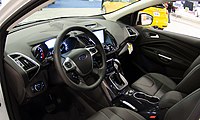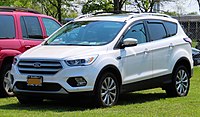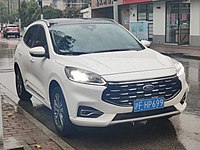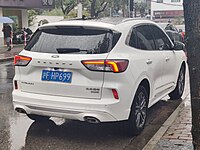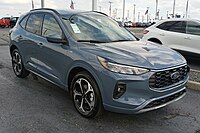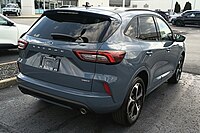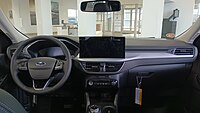| Ford Escape | |
|---|---|
 2021 Escape Hybrid (US) | |
| Overview | |
| Manufacturer | Ford Motor Company |
| Also called |
|
| Production | 2000–present |
| Model years | 2001–present |
| Body and chassis | |
| Class | Compact crossover SUV |
| Body style | 5-door SUV |
| Layout | |
| Chronology | |
| Predecessor | Ford Maverick (Europe) |
| Successor | Ford Territory (Middle East, South America, Philippines and Vietnam) |
The Ford Escape is a compact crossover SUV manufactured and marketed by Ford Motor Company since the 2001 model year. The first Ford SUV derived from a car platform, the Escape fell below the Ford Explorer in size; the Escape is currently sized between the Ford EcoSport and Ford Edge. The 2004 Ford Escape Hybrid was the first hybrid-electric vehicle from Ford, and the first hybrid produced as an SUV.
The first two generations of the Escape used the Ford CD2 platform (jointly developed with Mazda), leading to the release of the Mazda Tribute and Mercury Mariner; as with the Escape, both the Tribute and Mariner were marketed in North America. In Europe, the Escape was initially branded as the Ford Maverick from 2001 to 2008 (replacing a Nissan-produced SUV).
Under the mid-2000s "One Ford" globalization strategy, the third and fourth-generation designs of the Escape have been unified with the Ford Kuga, designed by Ford of Europe. Sharing a common body and chassis underpinnings (and several engines), the Escape and Kuga are manufactured in their home markets. As with previous generations, the fourth-generation Escape is offered with gasoline, hybrid, and plug-in hybrid options. Outside of North America, the Ford Escape is marketed in Australia, China, and Taiwan.
First generation (2001)
| First generation | |
|---|---|
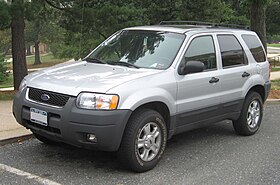 | |
| Overview | |
| Also called |
|
| Production |
|
| Model years | 2001–2007 |
| Assembly |
|
| Designer | Laurens van den Acker (1997) [3] [4] |
| Body and chassis | |
| Platform | Ford CD2 platform |
| Powertrain | |
| Engine |
|
| Transmission | |
| Dimensions | |
| Wheelbase | 103.1 in (2,619 mm) |
| Length |
|
| Width | 70.1 in (1,781 mm) |
| Height |
|
| Curb weight |
|
| Chronology | |
| Successor | Ford Kuga (Europe) |
The first generation of Ford Escape was released in 2000 for the 2001 model year. It was jointly developed with Mazda, in which Ford owned a controlling interest, and was released simultaneously with the Mazda Tribute. Although the Escape and Tribute shared the same underpinnings constructed from the Ford CD2 platform (based on Mazda GF underpinnings), the only panels common to the two vehicles were the roof and floor pressings. Powertrains were supplied by Mazda with respect to the base inline-four engine, with Ford providing the optional V6. At first, the twinned models were assembled by Ford in the US for North American consumption, with Mazda in Japan supplying cars for other markets. This followed a long history of Mazda-derived Fords, starting with the Ford Courier in the 1970s.
At the time, larger sport-utility vehicles tended to use pickup truck-based, body-on-frame designs. Other car makers, Jeep, Toyota and Honda had been offering smaller unibody designs, the Jeep Cherokee (XJ), RAV4 and CR-V respectively. Solid rear axles were commonly used on the full-sized truck-based SUVs and Jeep Cherokee due to their ability to carry heavy loads at the expense of a comfortable ride and good handling. Ford and Mazda decided to offer a car-like, unibody design with a fully independent suspension and rack and pinion steering similar to the RAV4 and CR-V in the Escape. [6] Although not meant for serious off-roading, a full-time all-wheel-drive (AWD) system supplied by Dana was optional, which included a locking center differential activated by a switch on the dashboard. [7] The AWD system normally sends most of the power from the engine to the front wheels. If slipping is detected at the front, more power will be sent to the rear wheels in a fraction of a second. The four wheel drive system was a newer version of Ford's "Control Trac" 4x4 system, dubbed the Control Trac II 4WD in the Escape. This system allowed the front wheels to receive 100% of the torque until a slip was detected. Using a Rotary Blade Coupling, the rear wheels could be sent up to 100% of the power in fractions of a second. When switching the system from "Auto" to "On," the front and rear axles are locked at a 50/50 split; the reaction time necessary to engage the rear wheels is reduced via an integrated bypass clutch. The Control Trac II system allows for a four-wheel drive vehicle without the use of a center differential. The entire braking system was built by Continental Teves, including the ABS and various related suspension components. [8]
Ford also sold the first generation Escape in Europe and China as the Ford Maverick, replacing the previous Nissan-sourced model. Then in 2004, for the 2005 model year, Ford's Mercury division released a rebadged version called the Mercury Mariner, sold mainly in North America. The first iteration Escape remains notable as the first SUV to offer a hybrid drivetrain option, released in 2004 for the 2005 model year to North American markets only. CKD production began in 2002 at Ford Lio Ho Motor Co. in Taiwan for various Asian markets. [9] One difference between the Tribute and the Ford Escape is that, in an effort to culture a sporty image, the Tribute's suspension is tuned for a firmer ride than the Escape.
Mainstream production of the first generation Escape/Tribute ended in late 2006. For Asia-Pacific markets, both received respective facelifts in 2006 and had production fully transferred to Ford Lio Ho in Taiwan. Extended production of the Mazda lasted until 2010, and until 2012 for Ford.
Ford Escape
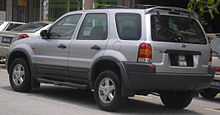
2000–2004 (BA, ZA)
In North America, it slotted below the larger, truck-based Explorer in Ford's lineup, but was marginally larger than the small SUV offerings from Honda and Toyota. [10] Although it is technically a crossover vehicle, it is marketed by Ford as part of its traditional SUV lineup (Escape, Explorer, Expedition) rather than its separate crossover lineup (Edge, Flex) due to its more conventional SUV styling.

From 2001 to 2004, the Ford Escape was sold in Europe under the Maverick name, and replaced a rebadged version of the Nissan Mistral/Terrano II. Only two versions were made, the 2.0 L Zetec inline-4 engine with manual transmission and 3.0 L Duratec V6 with automatic transmission, both using gasoline as fuel. The absence of a diesel version did not help sales and the vehicle was temporarily discontinued in late 2003. However, the Maverick, in the UK for example, was only available in XLT trim. Plus, the dashboard was not the same as the US Escape; it was instead taken from the Mazda Tribute. The Maverick was reintroduced in 2005 in certain European markets with the Duratec V6 engine. The Maverick was assembled in Russia for the Russian market. As of 2006, the Maverick was no longer sold in Europe, leaving Ford without a compact SUV until the 2008 Ford Kuga was introduced. The Maverick was primarily designed for on-road use – sold with normal road tires, and to be used with front-wheel drive most of the time.
In the Philippines, Ford introduced the Escape in 2001. It originally came in two grades; "XLT" & "XLS", but by early 2004, Ford axed the "XLT" (all-wheel drive model) and replaced it with the newly introduced "V6" trim. The "XLS" is powered by Ford's 2.3L Duratec inline-four engine paired to a 4-speed automatic. It came with keyless entry, fabric upholstery, 4 speakers, 6 CD audio system, among other features. [11] The "V6" is powered by Ford's 3.0L V6 engine paired to a 4-speed automatic. It featured a power moon roof, leather upholstery, automatic seat adjusters & recliners, keyless entry & immobilizer. [12]
Safety
Crash-test results for the Escape have been mixed. In the New Car Assessment Program administered by the USA-based National Highway Traffic Safety Administration, the car received five out of five stars for driver protection and four out of five stars for passenger protection in a 35 mph (56 km/h) frontal impact. [13] The SUV received five stars for both driver and rear passenger in the side impact test. In the Insurance Institute for Highway Safety's 40 mph (64 km/h) frontal offset test, 2001–2004 Escapes received a score of "Marginal". [14] In the side impact crash test, vehicles equipped with the optional side air bags received a score of "Good" in the 31 mph (50 km/h), while those without the optional air bags received a score of "Poor". [15]
All Escapes are equipped with a passive 'Immobiliser' called SecuriLock. This feature includes an 'RFID' chip embedded in the key, which the car reads each time the driver inserts the key. If the key doesn't provide a valid confirmation signal, the vehicle does not run, even if the key is perfectly cut to match the original. Theft, injury, and collision losses reported to insurance companies for the Escape are among the lowest in its class. [16]
North America
In the United States, all Escapes included standard equipment such as power windows with an automatic driver's side window, power door locks, anti-lock braking system (ABS), keyless entry, a folding rear-bench seat, 16-inch wheels, and air conditioning. In addition, an Escape buyer could choose from one of several different trim levels that were available, which included:
XLS (2001–2007): As the most basic trim level of the Escape, the XLS included: the 2.0-liter Zetec (2001–2004) and the 2.3-liter DuraTec (2005–2007) engines, a five-speed manual transmission, 15-inch steel wheels, an AM/FM stereo with cassette and CD players (later, just a single-CD player in 2005, adding MP3 capability in 2007 along with SIRIUS) and four speakers, high-back front bucket seats, and cloth-and-vinyl seating surfaces. Options include 15- or 16-inch alloy wheels, the 3.0-liter V6 engine (2001–2004), and a four-speed automatic transmission (some of which was available as the XLS Popular Group).
XLT (2001–2007): As the top-of-the-line trim level of the Escape in 2001, and the most popular trim level of the Escape throughout its entire run (2001–2007), the XLT added the following equipment to the base XLS trim level: 16-inch alloy wheels, security alarm, cloth seating surfaces, and an enhanced interior. Options included an AM/FM stereo with a six-disc, in-dash CD changer (which later became standard equipment on all Escapes), the 3.0-liter V6 engine, a four-speed automatic transmission, a power sunroof, leather-and-vinyl-trimmed seating surfaces, and the seven-speaker premium audio system with amplifier and rear-mounted subwoofer.
XLT Sport (2002–2007): The XLT Sport was one of the more popular trim levels of the Escape from 2002 to 2007. It added equipment to the standard XLT equipment: the V6 engine, four-speed automatic transmission, sport interior trim, and 16-inch machined alloy wheels. Options were the same as the standard XLT trim level.
Limited (2002–2007): As the top-of-the-line trim level of the Escape from 2002 to 2007, the Limited trim level added the following equipment to the XLT Sport trim level: an AM/FM stereo with six-disc in-dash CD/MP3 changer, the seven-speaker premium audio system with amplifier and rear-mounted subwoofer, low-back front bucket seats, leather-trimmed seating surfaces, dual power heated front bucket seats, a security system, color-keyed exterior trim, luxury interior trim, and a unique front grille. Options were limited, but included a power sunroof.
Hybrid (2005–2007): Based on the midrange XLT trim level, the Hybrid included: the 2.3-liter DuraTec inline-four engine with an electric motor, power front bucket seats, low-back front bucket seats, enhanced partially-recycled cloth seating surfaces, and unique 16-inch alloy wheels. Options included a powered sunroof, a unique integrated GPS navigational system with hybrid information system, Sirius Satellite Radio, the seven-speaker premium audio system with amplifier and rear-mounted subwoofer, leather-trimmed seating surfaces, and a "two-tone" exterior paint scheme, with silver-painted lower exterior trim and front and rear bumpers.
2004–2006 (ZB)

The Escape and Tribute were updated in February 2004 for the 2005 model year with a new base engine (the 2.3 L [2261 cc, 140 cu in] Duratec 23), which replaced the Zetec 2.0 L (1983 cc, 121 cu in) 127 hp (95 kW) 4-cylinder. The most powerful engine remained the 200 hp (150 kW) Duratec 3.0 L (2976 cc, 181 cu in) V6, with new engine mounts. Ford also added advanced airbag and seatbelt safety systems, an intelligent AWD system, and exterior minor changes, which included a redesigned front bumper. The 2005 model year was the first with an automatic transmission available on the base four-cylinder models. The automatic shifter was moved from the column to the console on all models equipped with automatic transmissions. Ford also deleted the recline feature on the rear seats to improve the safety of occupants in the rear seats in the case of a rear crash.
2006–2008 (ZC; Asia-Pacific)
Previewed by the Ford Equator Concept in 2005, a revamped ZC Escape designed in Taiwan by Ford Lio Ho went on sale in the second half of 2006 for the Asian and Pacific markets (except South Korea, where the North American-market Escape is sold). [17] Major external changes included a redesigned front bumper, grille, headlights and hood, and rear bumper, as well as LED taillights.
On the inside, changes included a floor-mounted automatic-transmission shifter, in place of the column shifter, as well as a redesigned center stack containing audio and climate controls. Climate control is automatic on all models except the XLS. The Limited model also featured full color-coded bumpers, wheel arches and side moldings, as well as side mirrors with integrated LED indicators. Rear drum brakes have been replaced by disc brakes all round.
The 3.0 L V6 has been modified to reduce fuel consumption by over 10%,[ citation needed] while the 2.3 L 4-cylinder has improved midrange torque and an electronic throttle, as well as a slight increase in power to 109 kW (146 hp). Both engines had been certified to meet Euro III emission regulations. A four-speed automatic carried over and was the sole transmission choice. Two different four-speed automatic transmissions were used, CD4E for 3.0 L V6 and GF4AX-EL for 2.3 L 4-cylinder.
2008–2009 (ZD; Asia-Pacific)
Previewed by the Ford Escape Adventure Concept, the ZD Escape designed in Taiwan by Ford Lio Ho for Asia-Pacific markets went on sale in mid-2008, bringing numerous changes. In Australia, the V6 engine was dropped, leaving only the 2.3-liter four-cylinder. [18]
The model range was also simplified, with only a single specification available. Changes to the body included an all-new front bumper, grille, headlights and bonnet, featuring an enlarged Ford emblem set upon a three-bar chrome grille. At the rear, new, slimmer tail lights were featured, which were arranged horizontally, rather than vertically. In addition, the B-pillar was now painted black, rather than body-colour. Compared with the previous model, all external bumpers, mirrors, and cladding were painted the same colour as the body (previously, this was only available on the upscale Limited model). Equipment levels have also improved. Compared to the base model ZC Escape, the ZD included standard side airbags, automatic climate control, 16" alloy wheels, and mirrors with integrated indicators. Unlike most other competitors in its class, curtain airbags and electronic stability control were not available.
2009–2012 (ZD; Asia-Pacific)
In 2009, another facelift of the ZD Escape developed by Ford Lio Ho brought about a new grille and front bumper. Chrome trim was completely removed from the grille, replaced with a smaller, black honeycomb grille as the last Ford Escape. In its final years, it was sold side by side with its successor, Ford Kuga until the Kuga replaced it in 2013.
Mercury Mariner
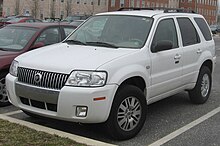
Introduced in 2004 for the 2005-model-year refresh of the Ford Escape in the US, Ford's Mercury division released a version called the Mercury Mariner. The Mariner is Mercury's first car-based SUV, and was slotted below the Mercury Mountaineer in its lineup. The Mariner was officially offered in the US, Mexico, Saudi Arabia, Kuwait, and the UAE. The Mariner includes stylistic differences, such as a two-tone interior, turn signal repeaters borrowed from the European-market Ford Maverick (the Escape's name in Europe), monotone cladding, and the Mercury "waterfall" front grille. Unlike its counterparts, Mercury did not offer a manual transmission as part of the powertrain lineup. The Mariner was the first Mercury with a four-cylinder since the Mercury Cougar was dropped in 2002. For 2006, the lineup was expanded with the introduction of the Mariner Hybrid. Sales ended after the 2007 model, replaced by a second generation, again a rebadged Ford Escape.
On September 7, 2006, Ford delivered a special "Presidential Edition" Mercury Mariner Hybrid to former President Bill Clinton. Its custom features include: LED lighting, 120 V outlet, rear bucket seats, center console & rear seat fold-out writing desks, personal DVD players for each seat, refrigerator, increased rear seat legroom. There have also been several undisclosed security modifications made to the vehicle. [19]
The Mariner Hybrid powertrain was identical to its sibling, the Ford Escape Hybrid. It was launched to the U.S. market in 2006 and was discontinued in 2010 (in the second generation) when the Mercury car division itself was discontinued by Ford. The Mariner hybrid sold a total of 12,300 units. [20]
Like the Ford Escape Hybrid, the Mariner Hybrid is a "full" hybrid electric system, meaning the system can switch automatically between pure electric power, pure gasoline engine power, or a combination of electric battery and gasoline engine operating together, for maximum performance and efficiency at all speeds and loads. When braking or decelerating, the Mariner's hybrid system uses regenerative braking, where the electric drive motor becomes a generator, converting the vehicle's momentum back to electricity for storage in the batteries. With 155 hp (116 kW), the Mariner Hybrid has nearly the same acceleration performance as the conventional 200 hp (150 kW) V6 Mariner. Again, just like the Escape Hybrid, it gets a respectable average of 34 miles per US gallon (6.9 L/100 km; 41 mpg‑imp) and is sometimes said to be the most fuel efficient sport utility vehicle on the road. [21]
Hybrid

The Ford Escape Hybrid and Mercury Mariner Hybrid are the gasoline-electric hybrid powered versions that launched in the U.S. in 2004 for the 2005 model year. Assembled in Kansas City, Missouri, it was the first hybrid SUV produced for sale and the first hybrid from an American manufacturer (alongside the Chevrolet Silverado/GMC Sierra Hybrids during the same model year). According to the Environmental Protection Agency, the first-generation Ford Escape Hybrid is 70% more efficient than the regular Escape. While the Mercury Mariner was also offered as a hybrid, the option was not available on the Mazda Tribute.
Escape hybrid versions can be identified by the "Hybrid" badges located on the front driver's and passenger's doors as well as near the right tailgate. In addition, the driver's side window in the cargo area is smaller to accommodate a ventilation slot for the high voltage battery. There was also a "Special Appearance Package" available as an option on the 2005–2007 Hybrid models. This package replaced the traditional lower cladding of the Escape with a silver finish. Standard equipment on the Escape Hybrid includes: an eight-way power adjustable driver's seat, dual-zone automatic air conditioning, cruise control, a six- CD stereo, 16-inch alloy wheels, power door locks with remote keyless entry, and power windows.
Ford built 17,000 Escape Hybrids in the second half of 2004, four times as many as it had originally planned. [22] Starting in 2005 New York City and other cities in the world began using the Ford Escape Hybrid as taxicabs. [23] The Ford Escape Hybrid won the North American Truck of the Year award in 2005. [24]
Drivetrain technology
The Escape Hybrid uses hybrid technology similar to that used in the Toyota Prius. Ford engineers realized their technology may conflict with patents held by Toyota, which led to a 2004 patent-sharing accord between the companies, licensing Ford's use of some of Toyota's hybrid technology [25] in exchange for Toyota's use of some of Ford's diesel and direct-injection engine technology. [26] Ford maintains that Ford received no technical assistance from Toyota in developing the hybrid powertrain, but that some hybrid engine technologies developed by Ford independently were found to be similar to technologies previously patented by Toyota, so licenses were obtained. [26] Aisin Seiki Co. Ltd., a Japanese automotive components supplier belonging to the Toyota Group, supplies the HD-10 hybrid continuously variable transmission for the Escape Hybrid. While Toyota produces its third-generation Prius transmission in-house, Aisin is the only supplier of hybrid transmissions to other manufacturers. Friction has arisen concerning Aisin's allocation of limited production capacity and engineering resources to Ford. [26] Sanyo Electric Co. built the 50 kg (110 lb), 330 volt [27] 5.5 Ah (would make it 1.8kWh storage), 250-cell nickel metal hydride (NiMH) battery pack for the 2005 Escape Hybrid. [28]

The Escape Hybrid is a full hybrid, meaning the system can switch automatically between pure electric power, pure gasoline engine power, or a combination of electric battery and gasoline engine operating together, for maximum performance and efficiency at all speeds and loads. When braking or decelerating, the Escape's hybrid system uses regenerative braking, where the electric drive motor becomes a generator, converting the vehicle's momentum back to electricity for storage in the batteries. The Escape Hybrid's 133 horsepower (99 kW) Atkinson cycle gasoline I4 engine and electric motor combine to give 155 hp (116 kW), which gives the Hybrid Escape nearly the same acceleration performance as the conventional 200 hp (150 kW) V6 Escape due to the electric motor's torque being available from zero rpm.
The hybrid is said to give approximately 75% greater efficiency, the FWD version has EPA ratings of 30 mpg and 28 highway, with combined 29 mpg. The AWD version EPA ratings 28 city and 26 highway, combined 27 mpg -U.S. in city traffic, and has demonstrated it can travel 400–500 miles (644–805 km) on a single 15.0-U.S.-gallon (57 L; 12.5 imp gal) mpg-U.S. (7.6L-8.1 L/100 km; 35–37 mpg-imp) on the highway. To obtain these mileage figures, the owners manual states that pure gasoline, not ethanol blends, must be used. In 2006, Ford showed an Escape that could run on E85 fuel.
Unlike conventional vehicles, hybrids often achieve better figures in the city because they do not waste power idling and can recover some power when stopping (by using regenerative braking) that would be wasted in a conventional vehicle.
Recalls
Subframe failure
In April 2014, Ford issued a recall on 386,000 Ford Escapes and Mazda Tributes for model years 2001–2004 for Escapes manufactured October 22, 1999, through January 23, 2004, for Canada and the northern "salt belt" states in the US. Subframe rust can result in the lower control arm mount breaking or detaching from the subframe, resulting in a loss of steering control and the risk of crash. Dealers have installed a crossbrace reinforcement to any vehicle affected by the recall. Model years 2005–2007 were not affected. [29] [30]
Second generation (2008)
| Second generation | |
|---|---|
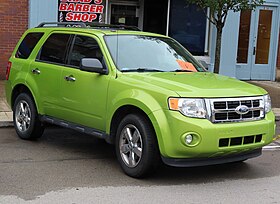 | |
| Overview | |
| Also called |
|
| Production | January 29, 2007 – April 28, 2012 |
| Model years | 2008–2012 |
| Assembly | United States: Claycomo, Missouri ( KCAP) |
| Designer | Doyle Letson (2004) [31] |
| Body and chassis | |
| Platform | Ford CD2 platform |
| Powertrain | |
| Engine |
|
| Transmission |
|
| Dimensions | |
| Wheelbase | 103.1 in (2,619 mm) |
| Length | 174.7 in (4,437 mm) |
| Width | 71.1 in (1,806 mm) |
| Height |
|
| Chronology | |
| Successor | Mazda CX-5 (for Tribute) |

The second generation Ford Escape debuted at the 2006 Los Angeles International Auto Show. [32] The North American-market Escape and its Mazda Tribute and Mercury Mariner siblings were redesigned to stay competitive with other new compact SUVs, however most of the internals have been carried over for the 2008 model year. The Escape still uses the CD2 platform. [33] Ford also included an electronic stability control system standard on the 2008 Escape. [34] The Mercury version lasted until late 2010, withdrawn from the market as part of the closure of the Mercury brand, with Mazda's Tribute ending production in late 2011. Ford ended manufacture of the second series Escape in 2012.
The updated Escape received some styling cues from the Explorer, Edge, and Expedition. Changes include a new grille with larger headlamps in the front fascia, while the sides were revised with cleaner lines and rounder wheel arches. The interior is also completely redesigned, including the newest standard Ford family navigation system. [35]
The 2008 Escape and its Mercury Mariner sibling were the first vehicles to feature Ford's pull-drift steering mode, an enhancement made possible by applying software control to the Electric Power Steering (EPS) system. [36]
The 2008 models of all three CD-2 versions retained the previous generation's engines and transmissions. In 2009, all three versions receceived engine and transmission upgrades that increased performance and fuel economy.
Ford ended production on the second generation Escape in 2011 and moved production to its Louisville Assembly Plant in Louisville, Kentucky, where it was succeeded by a new Escape based on its European CUV counterpart, the Ford Kuga. [37]
Ford
A new concept version for the Asian market, called the Ford Escape Adventure Concept, was revealed at the 2007 Tokyo Motor Show. It features a revised front and rear fascia, incorporating Ford's three-bar grille styling theme and restyled LED tail lamps.
Starting with the 2009 model, the 2.3 L Duratec 23 was replaced by a new 2.5 L (2488 cc, 152 cu in) Duratec 25 4-cylinder, [38] which boosted standard power to 171 hp (128 kW) and 171 lb⋅ft (232 N⋅m) of torque, while increasing fuel economy by 1 mpg (~2L/100 km) on both urban and extra-urban cycles. The optional 3.0 L Duratec 30 V6 was thoroughly updated, resulting in a 40 hp (30 kW) increase, bringing power output to 240 hp (180 kW) and 223 lb⋅ft (302 N⋅m) of torque. The Duratec 30 also sees a 1 mpg‑US (240 L/100 km; 1.2 mpg‑imp) fuel economy improvement. Another significant change was the switch to Ford's new 6F35 6-speed automatic, which became standard on all V6 equipped models and optional on the I4.
The Hybrid is also upgraded to use the 2.5 L (albeit still using the Atkinson cycle for better fuel economy). Efficiency improved to 34 mpg‑US (6.9 L/100 km; 41 mpg‑imp) city and 31 mpg‑US (7.6 L/100 km; 37 mpg‑imp) highway according to the USEPA. The 2.5 L engine brings the Hybrid's power output up by 22 hp (16 kW) to 156 hp (116 kW) combined when the electric motor is added in. In addition, the 2009 hybrid model changed the air conditioning compressor from an engine driven belt to electrically powered by the HV traction battery. This allowed the air conditioning system to continue cooling while the gas engine was off for example while at stop lights.
Other mechanical changes include a new 18.5 mm (0.73 in) rear stabilizer bar, revised suspension tuning, upgrades to the 3.0 L V6 that brought power to 240 hp, [38] and a new exhaust system on all Escapes. The braking system for the Hybrid versions has been revised with a vacuum assist unit that reviewers have said give the brakes a consistent feel over the entire travel of the brake pedal. [38] Previous versions of the Hybrid were reported to have a slightly mushy brake feel, primarily due to the fact that for the first part of the brake travel and braking the system is regenerating power instead of engaging the brake pads against the rotors. However, the brakes, when tested, gave the Escape extremely long stops.
This generation also saw the introduction of the optional "sport appearance package", which includes the upgraded 3.0L V6, changed the front grille from chrome to gloss black, added a gloss black appliqué to the front bumper, changed the rocker covers and door handles from unpainted black plastic to body-coloured, added a gloss black rear spoiler, black headlamp housings, black 17" rims, black cloth/leather interior with piano black trim and removes any exterior "V6" badging. This option was only available on the XLT trim level and only with ingot silver, sterling grey, steel blue or tuxedo black metallic paints. The "Escape" badge is entirely removed from the front doors.
In 2009, Ford's SYNC system is standard on the Hybrid, Hybrid Limited, and conventional Limited models, and optional on the XLS and XLT.
The Escape underwent some minor aerodynamic changes for 2009, including a revised front chin spoiler and rear tire spoilers. Along with the addition of rear tire spoilers is an optional 17" chrome-clad wheel equipped with a new Michelin "Low-Rolling-Resistance-Tire", slightly increasing ground clearance and improving traction over the standard 16" wheels and tires. Another new feature is Ford's Easy-Fuel capless fuel filling system. [39]
As of August 2009 the Escape was among the four Ford vehicles, along with the Focus, F-Series and Ranger, to benefit the most from the Cash for Clunkers program, where it showed a 49 percent increase in sales. [40]
In 2009 for the 2010 model year, the Escape will add three new features that will be standard on all trims: Ford's MyKey, trailer sway controls and Integrated Spotter Mirror for better blind spot viewing. Everything else added in the 2008 and 2009 model years will be carried over, but the optional orders have been renamed to Rapid Specification Codes (100s for XLS, 200s for XLT, and 300s for Limited).
New optional features for 2010: active park assist (APA) is a new feature available since mid-2009 as an option on the 2010 Ford Escape Limited (currently only optional on the Ford Flex, Lincoln MKT, and Lincoln MKS). Active Park Assist will detect an available parallel parking space and automatically steer the vehicle into the space (hands free) while the driver controls the accelerator, gearshift and brakes. The system will visually and audibly instruct the driver to park the vehicle. Active Park Assist system uses sensors on the front and rear of the vehicle to guide the vehicle into a parking space. Rear-view camera system – uses an exterior camera embedded in the rear of the vehicle that sends images to a video display in the rearview mirror or the navigation system screen to help enhance visibility directly behind the vehicle when it is in reverse.
No cosmetic changes were made for the 2011 model year. The only minor change is the standardization of SYNC Traffic & Directions on any models coming equipped with Sync. [41]
There are no cosmetic or equipment changes for the 2012 model year. The third-generation Escape was unveiled at the 2012 North American International Auto Show in Detroit.
Previously unavailable Electronic Stability Control system became standard on the second generation. [42] In Insurance Institute for Highway Safety crash tests the Escape along with its cousins, the Mercury Mariner and the Mazda Tribute, are rated "Good" in both frontal and side impact crash tests. [43] [44] They are rated "Good" for rear crash protection as well [45] and were given the "Top Safety Pick" award until 2010. In roof strength tests the Escape receives a "Marginal" rating while hybrid models are rated "Poor". [46]
Mazda

In 2007 for the 2008 model year, the Tribute was significantly revamped, like its Ford Escape and Mercury Mariner siblings. Originally set to be renamed the Mazda CX-5, the vehicle kept the Tribute name. The changes were significant, but fell short of a "clean sheet" redesign, as the vehicles remained on the CD2 platform, and kept the old 2.3 L MZR I4, and 3.0 L AJ V6 engines. Visible changes include all new sheet metal and interior. The interior was significantly upgraded using all new components and higher quality materials, and was generally praised by automotive journalists. [35] However, unlike the first generation of the Tribute, which had unique exterior and interior from its siblings, the new model only differs from its siblings in the "nose" (front fenders, hood, and front fascia), tail lights and detailing. Notable changes to the exterior include higher belt line, and more pronounced wheel arches. Overall the car was to look larger and more substantial than the previous model. As a cost-saving measure, the rear brake was reverted to drum brake, with predictable criticisms. [47] [48]
The 2008 Mazda Tribute (non-hybrid) was first unveiled at the 2007 Montreal International Auto Show, and the 2008 Mazda Tribute went on sale in March 2007. [49] A new addition was the Hybrid model, which was previously only available on the Ford Escape and Mercury Mariner.
The Tribute received additional major changes to improve performance for the 2009 model year, mostly by way of mechanical upgrades. Most significantly, all new engines replaced the increasingly outmatched 2.3L I4 and 3.0L V6. Mazda's new MZR 2.5L I4 replaced the 2.3L, boosting horsepower to 171 bhp (128 kW; 173 PS) and 171 lb⋅ft (232 N⋅m) of torque at 4000 rpm. [50] Despite increased horsepower, fuel economy also increased by 1 mpg‑US (240 L/100 km; 1.2 mpg‑imp) on both urban and extra-urban cycles. The optional 3.0 L ( AJ) V6 was thoroughly updated, resulting in a 40 hp (30 kW) increase, bringing power output to 240 hp (180 kW) and 223 lb⋅ft (302 N⋅m) of torque. It also sees a 1 mpg improvement. The Tribute Hybrid was dropped after the 2009 model year.
Another significant change was the switch to Ford's new 6F 6-speed automatic, which became standard on all V6 equipped models and optional on the I4. As well, new front and 18.5 mm (0.73 in) rear stabilizer bars were added for 2009 to improve ride handling after complaints about diminished performance following the 2008 changes. Others changes included redesigned seats, daytime running lamps, optional steering mounted audio controls, and other additional features. The Tribute was discontinued in November 2011 at the end of the 2011 model year, replaced by the Mazda CX-5 for 2012.
Mercury

For the 2008 model year the Mariner was significantly updated with a new look although it remained on the Ford CD2 platform used by the previous generation. The first 2008 Mercury Mariner was unveiled at the South Florida International Auto Show on October 6, 2006. The changes included a new seats, headlights, taillights, a new liftgate, a higher beltline and new doors and wheels. The interior was also significantly updated with higher quality materials and more refined features. The engines remained the same but the 3.0 L Duratec V6 has been modified to reduce fuel consumption by 10%.
The 2009 Ford Escape and Mercury Mariner were unveiled at the 2008 Washington Auto Show. Sporting a 2.5-liter engine and 6-speed automatic transmission that replaced the four-speed automatic transmission, the new powertrain improved the EPA fuel economy by 1 mile per gallon and increased power by 11% to 170 hp (127 kW). Also, the existing 3.0-liter Duratec V6 was bumped from 200 hp (149 kW) to 240 hp (179 kW). The new engine was also the new basis for Ford's hybrid models, including the Ford Escape Hybrid and Mercury Mariner Hybrid. "For every eight Escape and Mariner vehicles we sell, one of them is a hybrid, and the appeal is growing," says Sue Cischke, Ford senior vice president, Sustainability, Environment and Safety Engineering.
For the 2010 model year, the Mariner added Ford's MyKey and trailer sway controls as standard on all trim levels. The Mariner engine has a Flex-Fuel option on all models—meaning they can use E85 fuel or regular unleaded only on the optional V6 engine. Ford has also done away with the Euro-style turn signal repeaters for this model year. For the 2011 model year, the Mariner featured HD Radio as a standard, but continued with the same features as the 2010 models. This version of the Mariner was its last, as Ford discontinued the Mercury brand due to declining sales. Ford ended production of the Mariner in October 2010. The last one rolled off the assembly line on October 5, 2010.
Hybrid
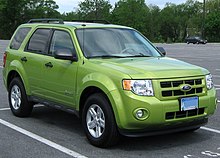
The second generation Ford Escape Hybrid received some minor styling tweaks inside and out. The major cosmetic changes included new bumpers, grille, headlights and taillights to match Ford's new edge style. But the drivetrain was essentially the same mechanically but has had extensive software modifications. [51] For 2009, a larger, more powerful engine was introduced, together with a revised suspension, addition of stability control, the debut of "Sync" voice-control system and a capless fuel filler system. [52] The batteries and other hybrid components in a 2009 Escape hybrid added about 136 kg (300 lbs) to the vehicle. However, the added weight was blamed for an adverse effect in handling. [53] Furthermore, from 2009 onward, rear disc brakes of previous years were swapped for drum brakes, which was criticized as a "strange step backward". [52]
The second generation Escape Hybrid was offered in two levels of specification, an undesignated base model and the more expensive "Limited" trim. The base included: a 60/40 split-fold rear bench seat, AdvanceTrac with roll stability control, and a single-disc four-speaker CD/MP3 stereo with Sirius Satellite Radio compatibility. The "Limited" adds: a chrome front grille, heated front seats, a six-way power driver's seat and full leather upholstery, rear park assist, ambient lighting, and 16-inch six-spoke alloy wheels. For the 2009 model year, Ford SYNC became standard on both Hybrid trims and the Ford Escape Hybrid replaced the "ESCAPE" badges on doors with "HYBRID," while relocating the logo for Ford hybrid models from near the driver's side doors next to the "HYBRID" text. 2010 models saw the addition of MyKey, trailer sway controls, and integrated spotter mirror for better blind spot viewing. New optional extras are active park assist and a rear-view camera.
Ford developed a prototype E85 Hybrid Escape, the first flexible fuel hybrid electric vehicle capable of running on 85% ethanol. [54] In 2007 Ford produced 20 demonstration Escape Hybrid E85s for real-world testing in fleets around the U.S. [55] [56]
From 2009, the gas engine was 2.5L Atkinson-cycle four cylinder engine with 155 hp at 6,000 rpm with an electric motor that produces 94 hp at 5,000 rpm. The maximum combined output of both was 177 hp. [57]
The U.S. Environmental Protection Agency (EPA) rated the fuel economy for the 2010 Escape Hybrid ( FWD) at 34 miles per US gallon (6.9 L/100 km; 41 mpg‑imp) city, and 31 miles per US gallon (7.6 L/100 km; 37 mpg‑imp) highway. [58] The following table compares fuel economy, carbon footprint, and petroleum consumption between the hybrid version and other drivetrains of the Escape family as estimated by the EPA and the U.S. Department of Energy. The Escape Hybrid met both California's SULEV and PZEV standards, with tailpipe emissions better than 90% less than the average 2003 new car and zero evaporative emissions. [59]
By early 2012 Ford discontinued the production of the Escape Hybrid due to the introduction of the third generation Escape. Two of the new 2013 model year Escapes have direct-injected and turbocharged EcoBoost units (of 1.6 and 2.0 liters) that deliver a higher fuel economy than the 2012 model. A total of 122,850 Escape Hybrids were built since 2005, along with 12,300 units of its sibling the Mercury Mariner Hybrid, discontinued in 2010. [20]
Plug-in hybrid


Three companies have converted Ford Escape Hybrids to plug-in under a contract with the NYSERDA and delivered them in 2007: Electrovaya of Toronto Canada, Hymotion also of Toronto Canada, Hybrids Plus of Boulder Colorado, United States. [60]
Ford developed a research Escape Plug-in Hybrid and delivered the first of a fleet of 20 to Southern California Edison (SCE) in December 2007 to begin road testing. This project was a collaboration aimed to explore the future of plug-in hybrids and evaluate how the vehicles might interact with the home and the utility's electrical grid. Some of the vehicles were evaluated "in typical customer settings", according to Ford. [61] [62] [63] Ford also developed the first ever flexible-fuel plug-in hybrid SUV, which was delivered to the United States Department of Energy in June 2008. This plug-in version of the Escape Hybrid runs on gasoline or E85 and is also part of the demonstration fleet Ford developed in a partnership with Southern California Edison and the Electric Power Research Institute. [64]
Both the E85 version and the conventional gasoline engine version use a 10 kwh lithium-ion battery, which allows for a 30-mile (48 km) range at 40 miles per hour (64 km/h) or less. When the battery's charge drops to 30%, the vehicle switches to its four-cylinder engine, assisted by the batteries, operating as a regular hybrid electric vehicle. The vehicle has a display system that shows the driver how efficient the vehicle is at any given time. If the vehicle uses its engine and is running in traditional hybrid mode, fuel economy is rated at 88 miles per U.S. gallon (2.7 L/100 km; 106 mpg‑imp) in the city and 50 miles per U.S. gallon (4.7 L/100 km; 60 mpg‑imp) on the highway. [64] [65]
This fleet of 20 Ford Escape Plug-ins was field tested with utility company fleets in California, New York, Ohio, North Carolina, Alabama, Georgia, Massachusetts, Michigan, and Quebec, Canada, with sales scheduled to being in 2012. [65] [66]
In August 2009 Ford delivered the first Escape Plug-in equipped with intelligent vehicle-to-grid (V2G) communications and control system technology to American Electric Power of Columbus, Ohio. This technology allows the vehicle operator to program when to recharge the vehicle, for how long and at what utility rate. The battery systems communicate directly with the electrical grid via smart meters provided by utility companies through wireless networking. [67] During the two years since the demonstration program began, the fleet of Escape Plug-ins has logged more than 75,000 miles (121,000 km), and Ford plans to equip all 21 plug-in hybrid Escapes with the vehicle-to-grid communications technology. [67]
The Ford demonstration vehicles and Hybrids Plus conversions are similar. The conversion involves the replacement of the original NiMH battery, located on the floor of the trunk, with a larger capacity Li-ion battery, in the same location and substantially the same volume as the original battery. The Electrovaya and Hymotion conversions retain the original battery, and augment its capacity with a Li-ion battery that occupies a significant portion of the trunk. In all cases, the conversion also involves the addition of a charger and of a power plug.
Third generation (2013)
| Third generation | |
|---|---|
 | |
| Overview | |
| Also called | Ford Kuga |
| Production | April 2012 – 2019 |
| Model years | 2013–2019 |
| Assembly |
|
| Designer | Patrick Verhee, Stefan Lamm, Andrea Di Buduo, Kemal Curic (2010) [68] |
| Body and chassis | |
| Platform | Ford C1 |
| Powertrain | |
| Engine | |
| Transmission | 6-speed
SelectShift
6F35 automatic 6-speed PowerShift 6DCT450 automatic |
| Dimensions | |
| Wheelbase | 2,690 mm (105.9 in) |
| Length | 4,524 mm (178.1 in) |
| Width | 1,838 mm (72.4 in) |
| Height | 1,702 mm (67.0 in) |
| Curb weight | 1,580–1,707 kg (3,483–3,763 lb) |
The third-generation Escape was first shown at the 2011 Los Angeles Auto Show. It was designed and rebadged by Ford of Europe alongside the largely identical European-market Ford Kuga. [69] [70] It was released to North American markets in 2012 for the 2013 model year. Many markets that previously used the "Escape" nameplate have switched to "Kuga" under the One Ford program, apart from the Middle East where it still bears the "Escape" nameplate. [71]
The third-generation Escape is claimed to be 10 percent more aerodynamic than the previous generation. [72] Also new for the 2013 model year is the MyFord Touch entertainment system, which offers an all-new user interface and additional features. Another new feature is the optional hands-free liftgate. A person carrying the keyless entry transmitter can raise a foot under the rear bumper of the Escape to open the tailgate. [73] Ecofriendly seat fabrics are standard on lower trim levels, and the vehicle's carpeting is mostly constructed from recycled plastic water bottles. This allows the new Escape to be mostly recyclable at the end of its lifecycle.[ citation needed]
Production of the 2013 Ford Escape began 11 April 2012, with ceremonies in June 2012. [74] The production of the previous generation 2012 Escape ended on 28 April 2012, overlapping slightly in production with the 2013 model due to plant issues, with the 2012 Ford Escape vehicles being limited in availability at Ford showrooms.[ citation needed] In May 2012, the third-generation Escape became available at most dealerships across the United States, and was introduced in Canada starting June.
-
Rear view
-
Interior
Powertrain
The base engine is the 2.5 L Duratec naturally aspirated inline-four engine which makes 168 hp (125 kW; 170 PS) and 167 lb⋅ft (226 N⋅m) of torque. Two EcoBoost inline four-cylinder turbocharged engines are offered in North America, which are the 2.0 L which makes 237 hp (177 kW; 240 PS) and 250 lb⋅ft (340 N⋅m) of torque, and the debuting 1.6 L which makes 173 hp (129 kW; 175 PS) and 177 lb⋅ft (240 N⋅m) of torque. [75] Ford claimed that the fuel economy of the new 1.6 L EcoBoost engine will match that of the previous Ford Escape Hybrid, while the new 2.0 L engine produces more torque than the previous 3.0 L V6 unit. The 1.6 L was rated for 26 mpg‑US (9.0 L/100 km) compared to the old hybrid's 32 mpg‑US (7.4 L/100 km) combined by the EPA, though the Ecoboost compares more favorably on the highway with ratings of 32 mpg‑US (7.4 L/100 km) outperforming the hybrid's 30 mpg‑US (7.8 L/100 km).
The transmission is either a six-speed conventional automatic or dual-clutch automatic. [73] The previous generation's hybrid model with its 2.5 L Atkinson powertrain was indirectly replaced by the C-Max Hybrid, and the 3.0 L V6 engine was dropped. [76]
Trim levels
The third-generation Escape was offered with front-wheel drive in the S trim level, and front- or all-wheel drive in the SE, SEL, and Titanium trim levels. [77] The SEL trim was discontinued after the 2013 model year, but was reintroduced for 2018.
For the 2015 model, in the United States and Canada, Ford updated the standard naturally aspirated 2.5 L four-cylinder engine's specification to 168 hp (125 kW) and 170 lb⋅ft (230 N⋅m) of torque.
2017 refresh
On 18 November 2015, Ford unveiled a refreshed mid-cycle update of the Escape, which went on sale in the beginning of 2016 for the 2017 model year. The refresh added an Edge-inspired front fascia, while tweaking the rear end that now sports reshaped LED taillights and a newly adopted two-slat, hexagonal grille. The interior was also adjusted slightly in the cabin area and on the steering wheel.
The Sync 3 infotainment system was added as a new feature, along with a new smartphone app called Sync Connect, which allows owners to remotely monitor their vehicle, check fuel levels, lock and unlock doors, and start the engine. The 2.5 Duratec and 2.0 EcoBoost engine line-up was joined by a new 179 hp (133 kW; 181 PS) 1.5 L turbocharged four-cylinder option, replacing the 1.6 L. [78]
Ford engineers promised additional refinement to the 2017 Escape, particularly as evidenced by extremely low road- and wind-noise levels. The doors and B pillars are insulated, the front wheel wells are lined, and acoustic glass is used for the side windows. Also, new seals are used for the windshield and hood. The new Escape showcased a number of new-to-it features, from faster-charging USB ports to an application that lets drivers unlock the vehicle and start the engine through a smartphone.
Dubbed Sync Connect, this feature helps to locate the vehicle in a crowded parking lot, check the fuel level, and alert the owner when service is due. A number of driver-assist features were available: Enhanced park assist, lane-keeping, forward collision warning, and adaptive cruise control. [79] Production of the facelifted 2017 Ford Escape started on 18 March 2016, at the Louisville Assembly Plant in Kentucky. [80]
-
2018 Escape Titanium
-
Rear view
Safety
| Overall: | |
| Frontal – Driver: | |
| Frontal – Passenger: | |
| Side – Driver: | |
| Side – Passenger: | |
| Side Pole – Driver: | |
| Rollover FWD: | |
| Rollover AWD: |
| Moderate overlap frontal offset | Good [83] |
| Small overlap frontal offset (driver) 2013–16 | Poor [84] |
| Small overlap frontal offset (driver) 2017–19 | Acceptable [84] |
| Small overlap frontal offset (passenger) 2013–19 | Poor [85] |
| Side impact | Good [86] |
| Roof strength | Good [87] |
Recall
In March 2017, Ford recalled 692,700 2014 Escapes because of faulty door latches. [88]
Fire hazard
In December 2012, Ford recalled over 70,000 Escapes in the United States and Canada with 1.6 L engines that may overheat and cause fires, after 12 reports of fires in Escapes were reported to Ford. [89]
In November 2013, Ford recalled over 160,000 Escapes with 1.6 L EcoBoost engines because of oil and fuel leaks that could lead to engine fires, after 13 fires caused by leaks were reported to Ford; the recall also covered about 12,000 to correct fuel lines installed incorrectly that could become chafed and leak gasoline. [90]
In March 2017, Ford recalled 2014 Escapes with 1.6 L EcoBoost engines because of a risk of engine fires caused by a "lack of coolant circulation". The recall partly contributed to a charge of US$300 million by Ford. [91] [92]
Fourth generation (2020)
| Fourth generation | |
|---|---|
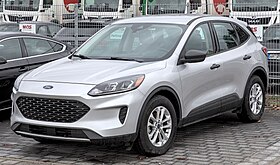 | |
| Overview | |
| Also called | Ford Kuga |
| Production | August 2019 [93] – present |
| Model years | 2020–present |
| Assembly |
|
| Designer | Andrew Bazinski
[94] Christopher Giroux, Nedzad Mujcinovic, Jordan Demkiw (facelift) |
| Body and chassis | |
| Platform | Ford C2 |
| Related | |
| Powertrain | |
| Engine |
|
| Electric motor | 88 kW (120 PS; 118 hp) permanent magnet synchronous |
| Power output | List
|
| Transmission | |
| Hybrid drivetrain | |
| Battery |
|
| Dimensions | |
| Wheelbase | 106.7 in (2,710 mm) |
| Length | 180.5 in (4,585 mm) |
| Width | 74.1 in (1,882 mm) |
| Height | 66.1 in (1,679 mm) |
| Curb weight |
|
| Chronology | |
| Predecessor | Ford C-Max (Escape Hybrid) |
The fourth-generation Escape debuted on April 2, 2019, and went on sale in the third quarter of 2019 as a 2020 model. It is manufactured at the Louisville Assembly Plant in Louisville, Kentucky. It is related to the third-generation Ford Kuga, outside North America.
Compared to its predecessor, the model is claimed to be lighter by over 200 pounds (91 kg) while occupying a footprint that is larger due to a wider track and longer length. With its larger size, the Escape provides more interior space for occupants by increasing headroom, shoulder space, and hip room for both rows of seats. Combustion-powered models are equipped with sliding second-row seats that allows a maximum of 37.5 cubic feet (1,062 L) of cargo space. [96]
In China, the fourth generation Escape has a slightly restyled front fascia compared to the North American version, and would be sold alongside the previous generation, which was sold as the Ford Kuga. [97] [98]
-
Rear view
-
Interior
Powertrain
There are four new engine-transmission combinations including a plug-in gas-electric hybrid that can go 37 miles (60 km) on electricity alone with an efficiency rating of 100 MPGe, [99] as well as a conventional hybrid and two turbocharged engines mated to an eight-speed automatic transmission.
The base engine, a turbocharged 1.5-liter inline three-cylinder, makes 181 hp (184 PS; 135 kW) and 190 lb⋅ft (258 N⋅m; 26.3 kg⋅m) of torque. It is paired with an eight-speed automatic transmission with front-wheel drive or optional all-wheel drive. An available turbocharged 2.0-liter four-cylinder engine makes 250 hp (253 PS; 186 kW) and 280 lb⋅ft (380 N⋅m) of torque but only comes with all-wheel drive.
The Escape Hybrid, returning after an extended absence, and all new plug-in hybrid are powered by a 2.5-liter gasoline inline-four that runs on the more efficient Atkinson cycle, along with two electric motors and a planetary gearset that combines the two power sources and allows for gear-ratio changes, essentially operating as a continuously variable automatic transmission. The standard hybrid's battery pack is rated at 1.1 kilowatt-hours, while the plug-in hybrid's is significantly larger, at 14.4 kWh with a 10.7 kWh usable capacity; both are lithium-ion packs that fit under the floor. Combined horsepower for the standard hybrid is 200 hp (203 PS; 149 kW), while the plug-in has 209 hp (212 PS; 156 kW) combined. [100] [101]
Markets
United States
In the United States, the Escape was available in five trim levels from 2020 to 2022: S, SE, SE Sport(2020 only, becoming an appearance package on SE trim from 2021 to 2022), SEL, and Titanium. All trims except for the S trim (only available with a gasoline engine) and the SE Sport (only available as a gasoline hybrid model) are available with gasoline-only, gasoline hybrid, and gasoline plug-in hybrid (PHEV) powertrains. All models offer a choice of either front-wheel drive or all-wheel drive, except for PHEV models which are only available with front-wheel drive. [102]
The PHEV model became available in U.S. dealers in October 2021 for the 2021 model year. [103]
Mexico
On October 17, 2019, this generation went on sale in Mexico with the 2.0-liter Ecoboost and 2.5-liter hybrid powertrains. [104] [105] For 2022, the Ecoboost engine was dropped and was indirectly replaced by the newly introduced Ford Territory, making the Escape a hybrid only model in the country.
Australia
The fourth-generation Escape became available in Australia in the third quarter of 2020, designated as the ZH series. [106] While marketed as the Escape, the Australian model adopts the exterior styling from the European Kuga as the vehicles are sourced from Spain. [107] Powertrain options include a 2.0-litre EcoBoost gasoline engine and a 2.5-litre plug-in hybrid. Trim levels offered are standard, ST-Line, and Vignale. [108] Ford discontinued the Escape in Australia in 2023 due to poor sales, and is being indirectly replaced by the electric Mustang Mach-E. [109]
Middle East
The fourth-generation Escape was launched in the GCC markets in 2021. It is powered by the 1.5-litre turbo petrol engine and it is offered in two grades, Ambiente and Trend. The Escape was discontinued in 2022 and was indirectly replaced by the Ford Territory. [110]
China and Taiwan
In China, the fourth-generation Escape was sold alongside its predecessor, which was sold as the Kuga in China. The Chinese market version features a restyled front fascia with a larger grille, and the blue oval logo being positioned in the center of the grille. [111] The same styling variant was also sold as the Ford Kuga in the Taiwanese market with the 1.5-liter engine models, while 2.0-liter engine models were sold with European style front grille.
-
Ford Escape (China)
-
Rear view
-
ST-Line
2023 refresh
Ford announced a refreshed Escape lineup for the North American market in October 2022 for the 2023 model year. [112] The exterior featured minor changes including an updated grille and headlights, restyled taillights that lack amber turn signal bulbs in the US and an optional front light bar. While the power output remains the same, both EcoBoost engines were heavily reworked to meet emissions standards. The hybrid and plug-in hybrid were only slightly modified, and power ratings drop slightly due to following new SAE J2908 measurement methods.
The interior features updates to the console and infotainment system. All models now come with a digital gauge cluster, with an 8-inch screen flanked by digital temperature and fuel level gauges coming standard, and the optional 12.3 inch LCD dashboard is retained with updated graphics. The 8-inch LCD infotainment system is retained for lower models, while higher models receive a new 13.2 inch infotainment system with SYNC 4. Models with the 8-inch infotainment screen retain physical knobs and buttons for the climate controls, while the new larger screen setup only has up to 6 shortcut buttons and a volume knob; all climate and vehicle settings are controlled via the touchscreen.
The previous trim lineup was entirely replaced, with the S, SE, and Titanium trims supplanted by Base, Active, and Platinum, respectively; the SEL trim was also discontinued and indirectly replaced with three "ST-Line" trim levels. Meanwhile, the plug-in hybrid version, previously offered in combination with other trims, became a standalone trim. [113]
-
2023 Escape Hybrid
-
Rear view
-
Interior
Sales
Ford Escape
| Year | United States | Australia | Mexico [114] |
|---|---|---|---|
| 2000 | 42,635 [115] | ||
| 2001 | 164,184 [116] | 2,842 | |
| 2002 | 145,471 [117] | 3,606 | |
| 2003 | 167,678 | 3,238 | |
| 2004 | 183,430 [118] | 3,252 | |
| 2005 | 165,122 [118] | 2,685 | 9,796 |
| 2006 | 157,395 [119] | 2,852 | 9,716 |
| 2007 | 165,596 | 2,639 | 10,857 |
| 2008 | 156,544 [120] | 1,794 | 12,260 |
| 2009 | 173,044 | 1,039 | 8,281 |
| 2010 | 191,026 [121] | 3,034 | 8,916 |
| 2011 | 254,293 [122] | 2,512 | 10,938 |
| 2012 | 261,008 [123] [124] | 939 | 8,618 |
| 2013 | 295,993 [125] | 9,899 | |
| 2014 | 306,212 [126] | 7,773 | |
| 2015 | 306,492 [127] | 7,085 | |
| 2016 | 307,069 [128] | 7,625 | |
| 2017 | 308,296 [129] | 6,744 | |
| 2018 | 272,228 [130] | 5,276 | |
| 2019 | 241,388 | 3,939 | |
| 2020 | 178,496 [131] | 1,398 | |
| 2021 | 145,415 | 1,455 | |
| 2022 | 137,370 [132] | ||
| 2023 | 140,968 [133] |
Mercury Mariner
| Year | U.S. |
|---|---|
| 2004 | 7,171 [134] |
| 2005 | 34,099 |
| 2006 | 33,941 [135] |
| 2007 | 34,844 |
| 2008 | 32,306 [136] |
| 2009 | 28,688 [137] |
| 2010 | 29,912 [138] |
References
- ^ "Ford Escape to Go on Sale in August". autoworld.com.my. March 23, 2001. Archived from the original on May 16, 2015. Retrieved May 16, 2015.
- ^ Sarne, Vernon (June 27, 2012). "Ford makes 'business decision' to stop manufacturing cars in PH". Top Gear Philippines. Archived from the original on May 10, 2013. Retrieved June 3, 2013.
- ^ Revill, John (March 31, 2009). "Maeda named new Mazda design boss, replacing van den Acker". Automotive News. Retrieved October 17, 2017.
- ^ "Around-The-World Engineering. – Free Online Library".
- ^ a b c "Ford Escape: Specifications & Capacities for 2009 Models". Ford Vehicles. Archived from the original on April 11, 2009. Retrieved May 2, 2009.
- ^ "2001 Escape First Drive". Edmunds.com. January 1, 1999. Retrieved February 19, 2015.
- ^ "Dana Gets 4WD Contract for Ford/Mazda SUVs". Autoparts Report. April 25, 2000. Retrieved April 15, 2008.
- ^ "Continental Teves Supplies Brake System To Ford Escape/Mazda Tribute". Autoparts Report. June 2, 2000. Retrieved April 15, 2008.
- ^ "Dana Corp. To Supply 4wd System 2002 For Ford Escape in Taiwan – Brief Article". Autoparts Report. January 11, 2002.
- ^ Jamieson, Scott (August 2001). "Escaping debt: a reasonably priced alternative to full-sized pickups and SUVs, the Ford Escape has all the power and comforts required". Canadian Forest Industries. Retrieved April 15, 2008.
- ^ "2004 Ford Escape 2.3L XLS review". carguide.ph. August 11, 2004.
- ^ "2004 Ford Escape V6 review". carguide.ph. January 21, 2004.
- ^ "New Car Assessment Program: 2001 Ford Escape". National Highway Traffic Safety Administration. 2001. Retrieved April 16, 2008.
- ^ "IIHS-HLDI: Ford Escape". IIHS-HLDI. 2001. Archived from the original on May 14, 2016. Retrieved April 16, 2008.
- ^ "IIHS-HLDI: Ford Escape". IIHS-HLDI. 2003. Archived from the original on May 14, 2016. Retrieved April 16, 2008.
- ^ "Injury, Collision, & Theft Losses 2001–2003". HLDI. September 2004. Archived from the original (PDF) on October 20, 2018. Retrieved April 16, 2008.
- ^ "Ford Thailand has launched a revised Escape suv". AUTO in CAR. Autoincar.blogspot.com. September 27, 2007. Retrieved May 2, 2009. [ dead link]
- ^ Brogan, Matt (August 25, 2008). "2008 Ford Escape XLT Review". CarAdvice. Retrieved May 13, 2016.
- ^ "Clinton to get custom hybrid SUV". CNN. September 7, 2006. Retrieved November 9, 2009.
- ^ a b John Voelcker (May 22, 2012). "Green-Car Death List: 2012 Models To Which We Bid Adieu". Green Car Reports. Retrieved May 23, 2012.
- ^ "2009 Mercury Mariner Hybrid Review". Automoblog.net. November 11, 2008. Retrieved January 5, 2009.
- ^ Hybrid Sales Figures/Tax Credits for Hybrids Electric Drive Transportation Association. Retrieved August 24, 2007.
- ^ "FORD ESCAPE HYBRID TAXIS | Ford Motor Company Newsroom". Media.ford.com. Archived from the original on December 8, 2007. Retrieved June 9, 2012.
- ^ "NACTOY – Past Finalists & Winners". The North American Car and Truck of the Year Awards. Archived from the original on June 5, 2010. Retrieved July 13, 2010.
- ^ "Wall Street Journal Online – Toyota to License Hybrid Patents For Use by Ford – MARCH 9, 2004". The Wall Street Journal. March 9, 2004. Retrieved August 4, 2011.
- ^ a b c Cars.com – Ford Slams Toyota on Hybrids Archived March 8, 2012, at the Wayback Machine – Reported by Christine Tierney, Detroit News, August 8, 2005
- ^ "Escape specs". Ford. Archived from the original on June 28, 2008.
- ^ "2005 Ford Escape Hybrid Electric Vehicle" (PDF). HEV America, U.S. Department of Energy Advanced Vehicle Testing Activity. 2005. Archived from the original (PDF) on September 25, 2007. Retrieved August 7, 2007.
- ^ "Ford recalls another 386K for chassis corrosion". USA Today.
- ^ "Almost 400,000 Ford Escape SUVs Recalled over Rust". April 7, 2014.
- ^ Siler, Steve (November 2006). "2008 Ford Escape". Car and Driver.
- ^ "Ford toughens Escape for 2008". AutoWeek.com. Archived from the original on September 29, 2007. Retrieved November 29, 2006.
- ^ "2008 Ford Escape gets new look". Edmunds.com. Archived from the original on December 11, 2006. Retrieved March 16, 2006.
- ^ "Ford To Make Stability Control Standard by 2009". Edmunds.com. Archived from the original on May 4, 2007. Retrieved September 13, 2006.
- ^ a b "Sneak Peek: 2008 Ford Escape". Detroit News. Retrieved April 19, 2006.
- ^ "Ford Builds on Electric Power Steering Technology To Enhance Drift Mode, Enable More Features | Ford Motor Company Newsroom". Media.ford.com. March 12, 2009. Retrieved May 2, 2009. [ permanent dead link]
- ^ "Report: Ford to halt Missouri Escape production in 2011" from Autoblog (June 23, 2010)
- ^ a b c Burgess, Scott (May 28, 2008). "Ford Escape adds power, refinement". The Detroit News. Archived from the original on February 8, 2013. Retrieved September 1, 2009.
- ^ "FORD DELIVERS BETTER FUEL ECONOMY, MORE POWERFOR ESCAPE, MERCURY MARINER; EXPANDS E85 FLEET" (Press release). Ford Motor Company. January 22, 2008. Archived from the original on May 25, 2011.
- ^ Johnson, Kimberly S; Strumpf, Dan (September 1, 2009). "Auto sales post best month of year but could slow". Yahoo! Finance. Archived from the original on September 5, 2009. Retrieved September 1, 2009.
- ^ 2011 Ford Escape from conceptcarz (July 2010)
- ^ "IIHS-HLDI". Iihs.org. Archived from the original on April 7, 2010. Retrieved November 27, 2010.
- ^ "IIHS-HLDI: Ford Escape". Iihs.org. October 21, 2010. Archived from the original on November 6, 2010. Retrieved November 27, 2010.
- ^ "IIHS-HLDI: Ford Escape". Iihs.org. October 21, 2010. Archived from the original on May 28, 2008. Retrieved November 27, 2010.
- ^ "Head restraints: Ford". Iihs.org. Archived from the original on December 9, 2010. Retrieved November 27, 2010.
- ^ "Roof strength evaluations: Small SUVs". Iihs.org. Archived from the original on June 29, 2009. Retrieved November 27, 2010.
- ^ "2008 Mazda Tribute s Touring – First Drive Review". Car and Driver. June 2007. Retrieved January 11, 2009.
- ^ "2009 Mazda Tribute Review". Retrieved January 11, 2009.
- ^ "New CX-9 is Mazda's latest crossover". The Gazette. Archived from the original on March 24, 2007. Retrieved January 21, 2007.
- ^ "2009 Tribute". MazdaUSAMedia. Retrieved August 19, 2009.
- ^ "2008 Ford Escape Hybrid Reviews by Cars.com Experts and Consumers". Cars.com. Retrieved July 27, 2010.
- ^ a b "2009 Ford Escape Hybrid Road Test". Edmunds.com.
- ^ Peter Bleakney (September 1, 2010). "Test Drive: 2010 Ford Escape Hybrid Limited 4WD". Canadian Driver.
- ^ "Ford Develop's World's First Ethanol-Fueled Hybrid Marrying Two Gasoline-Saving Technologies" (Press release). Ford Motor Company. Archived from the original on February 4, 2006. Retrieved August 24, 2007.
- ^ "Ford delivers E85 hybrid vehicles". HybridCarBlog. June 11, 2007. Archived from the original on December 31, 2009. Retrieved March 16, 2010.
- ^ "Hybrids Running on E85 Ethanol Fuel: 5 Things to Know". GreenCar.com. March 16, 2009. Archived from the original on March 12, 2010. Retrieved March 16, 2010.
- ^ "Escape hybrid engine spec". Ford.com. Archived from the original on August 10, 2011. Retrieved August 4, 2011.
- ^ "2010 Ford Escape Hybrid | The Most Fuel-Efficient SUV on the Planet". FordVehicles.com. Archived from the original on August 19, 2010. Retrieved July 27, 2010.
- ^ http://driveclean.ca.gov/index.php Archived December 24, 2010, at the Wayback Machine DriveClean.ca.gov
- ^ "NYS Governor Announces Winners for PHEV Conversions". Calcars.org. Retrieved August 4, 2011.
- ^ "Ford Delivers First Escape Plug-In Hybrid To Southern California Edison" (Press release). Ford Motor Company. Archived from the original on November 18, 2011. Retrieved August 4, 2011.
- ^ "EERE News: EERE Network News". Eere.energy.gov. Retrieved August 4, 2011.
- ^ "Ford Motor Company And Southern California Edison Join Forces To Advance A New Transportation And Energy Vision" (Press release). Ford Motor Company. Archived from the original on May 16, 2008.
- ^ a b "Ford Motor Company Delivers Flexible Fuel, Plug-In Vehicle to Department of Energy" (Press release). Ford Motor Company. Archived from the original on June 22, 2009.
- ^ a b "Ford Escape Plug-in Hybrid". hybridCars.com. Archived from the original on September 12, 2009. Retrieved April 21, 2010.
- ^ Joddy Potter (May 12, 2009). "100 MPG in Ford Escape Plug-In Hybrid". The Birmingham News. Retrieved April 21, 2010.
- ^ a b "Ford announces electric vehicle-to-grid communications system". Autoblog.com.
- ^ "US D667341 S1". Google Patents. January 5, 2011. Retrieved May 12, 2016.
- ^ Cato, Jeremy (April 24, 2012). "Ford's Escape plan drives auto maker into the future". The Globe and Mail. Retrieved May 12, 2016.
- ^ Marx, Edward (April 26, 2012). "Ford Kuga". Auto Express. Retrieved May 12, 2016.
- ^ "Ford SUVs | Ford UAE".
- ^ "2014 Ford Escape SUV". www.ford.com. Dearborn, Michigan: Ford Motor Company. Archived from the original on April 19, 2014. Retrieved January 17, 2017.
- ^ a b Raynal, Wes (May 14, 2012). "New Leader?". Autoweek. 62 (10): 52–53.
- ^ "Ford kicks off 2013 Escape assembly [w/video]". Autoblog. Retrieved September 22, 2022.
- ^ Gall, Jared (November 15, 2011). "2013 Ford Escape Official Photos and Info". Car and Driver. Retrieved March 15, 2024.
- ^ "Ford Escape and C-Max 2012: New EcoBoost and hybrid engines". The Car Guide. October 13, 2011. Retrieved September 22, 2022.
- ^ "Ford Launches Official Configurator for 2013 Escape, S Model Starts at $23,295". MotorTrend. April 9, 2012. Retrieved September 22, 2022.
- ^ "2017 Ford Escape gets all edgy for LA" from Autoblog (18 November 2015)
- ^ Scott-AutoFile (November 16, 2015). "First look at the 2017 Ford Escape". Autofile.ca. Retrieved November 20, 2015.
- ^ "2017 Escape debuts new SYNC 3 with Apple CarPlay, Android Auto; new quality checks improve Ford's best-selling SUV" (Press release). Louisville, Kentucky: Ford. March 18, 2016. Retrieved March 20, 2016.
- ^ "2013 Ford Escape SUV 4x2". Nhtsa.gov. Retrieved September 22, 2017.
- ^ "IIHSHLDI: Ford Escape". www.iihs.org. Archived from the original on September 13, 2008. Retrieved June 18, 2013.
- ^ "IIHSHLDI: Ford Escape". www.iihs.org. April 30, 2013. Archived from the original on February 3, 2013. Retrieved June 18, 2013.
- ^ a b "IIHSHLDI: Ford Escape". www.iihs.org. August 2, 2016. Archived from the original on October 22, 2017. Retrieved March 16, 2017.
- ^ "2019 Ford Escape 4-door SUV". www.iihs.org. IIHS-HLDI crash testing and highway safety.
- ^ "IIHSHLDI: Ford Escape". www.iihs.org. September 6, 2012. Retrieved June 18, 2013.
- ^ "Roof strength evaluations: Small SUVs". IIHS.org. Archived from the original on 29 June 2009. Retrieved 18 June 2013.
- ^ Krisher, Tom (March 29, 2017). "Ford recalls 570,000 vehicles for engine fire risk, door latch trouble". The Globe and Mail. AP. Retrieved April 1, 2017.
- ^ "Ford recalls 2013 Escape, Fusion: Potential fires in 89,000 cars with 1.6-liter engine". Autoweek. December 2, 2012. Retrieved April 1, 2017.
- ^ Krisher, Tom (November 27, 2013). "Ford recalls hot-selling Escape SUV for seventh time after oil and gas leaks linked to 13 fires". The Financial Post. AP. Retrieved April 1, 2017.
- ^ Lynch, Jim (March 29, 2017). "Ford recalls 230,000 cars over potential engine fires". The Detroit News. Retrieved April 1, 2017.
- ^ "Ford recalls 440,000 vehicles for fire risk, door latch trouble". CBC. AP. March 29, 2017. Retrieved April 1, 2017.
- ^ bblfleet.com/fleetdocs/ford_buildout.pdf
- ^ Bruce, Chris. "2020 Ford Escape Lead Designer Was Inspired By Motorcycles".
- ^ "Ford Escape 2020 Technical Specifications" (PDF). Ford Media.
- ^ "2020 Ford Escape Debuts With Whole New Look, Two Hybrid Choices". Motor1.com. Retrieved September 22, 2022.
- ^ Ford Twitter
- ^ “This is the All New 2020 Ford Escape” from Ford Authority (April 2, 2019)
- ^ "Ford Escape plug-in hybrid sets the pace for SUVs with 37-mile range on battery alone". www.msn.com. Retrieved June 14, 2020.
- ^ Caparella, Joey (April 2, 2019). "The 2020 Ford Escape Looks to Fill a Car-Shaped Hole in the Lineup". Car and Driver. Retrieved April 2, 2019.
- ^ Caparella, Joey (April 2, 2019). "2020 Ford Escape Revives the Hybrid and Adds a Plug-In Variant". Car and Driver. Retrieved April 2, 2019.
- ^ "Ford Escape Prices, Reviews, and Pictures | Edmunds". Edmunds.com. August 4, 2020.
- ^ "2021 Ford Escape PHEV Arrives At Dealers After Lengthy Delay". InsideEVs. Retrieved September 22, 2022.
- ^ "Ford Escape 2020: Precios, versiones y equipamiento en México". October 17, 2019.
- ^ "Ford Shuffles its Compact SUV Portfolio in Mexico - the Detroit Bureau". www.thedetroitbureau.com. October 10, 2022. Retrieved March 15, 2024.
- ^ "Ford Escape ZH cars for sale in Australia". Carsales. Retrieved September 30, 2022.
- ^ "2020 Ford Kuga revealed". Drive. April 2, 2019. Retrieved September 22, 2022.
- ^ "2020 Ford Escape pricing and specs". Drive. February 25, 2020. Retrieved September 22, 2022.
- ^ Fraser, Tom (April 18, 2023). "Ford escape to be axed in Australia after 22 years". Drive Australia. Retrieved April 18, 2023.
- ^ "Ford Escape 2021 UAE Prices & Specs". Drive Arabia. Retrieved February 22, 2024.
- ^ "2020 Ford Escape Gets A Bigger Grille In China". Motor1.com. Retrieved November 24, 2022.
- ^ "2023 Ford Escape facelift unveiled in the US, Australian plans unclear". CarExpert. October 25, 2022. Retrieved November 24, 2022.
- ^ Foote, Brett (September 21, 2022). "2023 Ford Escape Trims Revealed, PHEV Becomes Its Own Thing". Ford Authority. Retrieved June 6, 2023.
- ^ "Venta al público y producción de vehículos ligeros por marca, modelo, segmento y país origen". Instituto Nacional de Estadística, Geografía e Informática (INEGI) (in Mexican Spanish). Retrieved October 30, 2021.
- ^ "Ford Motor Company Sets New Full Year U.S. Sales Record". Theautochannel.com. Retrieved April 28, 2009.
- ^ "Ford Motor Company's December U.S. Sales Climb 8.2 Percent" (PDF). Ford Motor Company. Archived from the original (PDF) on April 30, 2011.
- ^ "Ford's F-Series Truck Caps 22nd Year in a Row as America's Best-Selling Vehicle With a December Sales Record". Theautochannel.com. November 17, 2004. Retrieved April 28, 2009.
- ^ a b "Ford Achieves First Car Sales Increase Since 1999". Theautochannel.com. November 17, 2004. Retrieved June 6, 2009.
-
^
"Archived copy". Archived from
the original on February 12, 2009. Retrieved May 27, 2009.
{{ cite web}}: CS1 maint: archived copy as title ( link) - ^ "NEWS" (PDF). Archived from the original (PDF) on February 6, 2009. Retrieved October 4, 2009.
- ^ "Ford's 2010 Sales up 19 Percent – Largest Increase of any Full-line Aautomaker; Foundation Set for Growth in 2011" (PDF). Ford Motor Company. Archived from the original (PDF) on January 24, 2011.
- ^ Raynal, Wes (May 14, 2012). "New Leader?". Autoweek. 62 (10): 52–53.
- ^ "Ford Cars, Utilities and Trucks All Post U.S. Sales Gains in 2012; Company Posts Best December Sales Since 2006". Ford Motor Company. Archived from the original on January 6, 2013.
- ^ Jeff Cobb (January 8, 2013). "December 2012 Dashboard". HybridCars.com. Retrieved June 18, 2013.
-
^
"Archived copy" (PDF). Archived from
the original (PDF) on December 26, 2014. Retrieved March 27, 2017.
{{ cite web}}: CS1 maint: archived copy as title ( link) - ^ "Ford Posts Best U.S. December Sales Results since 2005; Ford Once Again Best-Selling Brand and Best-Selling Vehicle" (PDF). Ford. January 5, 2015.
- ^ "Ford Motor Company December U.S. Sales Results" (PDF). Ford Motor Company. January 5, 2016. Archived from the original (PDF) on February 10, 2016. Retrieved January 15, 2016.
- ^ "Ford U.S. December Retail Sales up 5 Percent – a 12-Year High; Ford America's Best-Selling Brand for Seventh Year". Ford News. January 4, 2017.
- ^ "Ford SUVs Post Record Sales" (PDF). Ford News. January 3, 2018.
- ^ "Ford F-Series Marks 42 Straight Years as America's Best-Selling pickup, Topping 900,000 Sold in 2018;" (PDF). Ford News. January 3, 2019.
- ^ "Truck Customers Make F-Series America's Best-Selling Pickup For 44 Straight Years;" (PDF). Ford News. January 6, 2021.
- ^ "F-Series Captures America's Best-Selling Truck Crown For 46th Straight Year; Ford Posts Record Electric Vehicles Sales, Harnesses No. 2 EV Automaker Spot; Ford Expands Total Market Share In 2022". Ford Media Center. January 5, 2023. Retrieved January 9, 2023.
- ^ "Ford U.S. Sales Rise 7.1% to Nearly 2 Million Vehicles in 2023". Ford Media Center. January 4, 2024. Retrieved January 13, 2024.
- ^ "Ford Achieves First Car Sales Increase Since 1999". Theautochannel.com. November 17, 2004. Retrieved April 28, 2009.|
- ^ "Ford Motor Company 2007 sales". media.ford.com. January 3, 2008. Archived from the original on February 12, 2009.
- ^ "F-Series drives ford to higher market share for third consecutive month" (PDF). media.ford.com. January 5, 2009. Archived from the original (PDF) on February 6, 2009. Retrieved May 14, 2009.
- ^ "Ford caps 2009 with 33 percent sales increase, first full-year market share gain since 1995 | Ford Motor Company Newsroom". media.ford.com. January 5, 2010. Archived from the original on August 26, 2010. Retrieved September 30, 2010.
- ^ "Ford's 2010 sales up 19 percent – largest increase of any full-line automaker; foundation set for growth in 2011" (PDF). media.ford.com. Archived from the original (PDF) on January 24, 2011. Retrieved May 20, 2011.
External links
- Ford vehicles
- Compact sport utility vehicles
- Crossover sport utility vehicles
- Front-wheel-drive vehicles
- All-wheel-drive vehicles
- Ford CD2 platform
- Motor vehicles manufactured in the United States
- Hybrid sport utility vehicles
- Flexible-fuel vehicles
- Partial zero-emissions vehicles
- Plug-in hybrid vehicles
- Cars introduced in 2000
- 2010s cars
- 2020s cars
- Vehicles with CVT transmission









